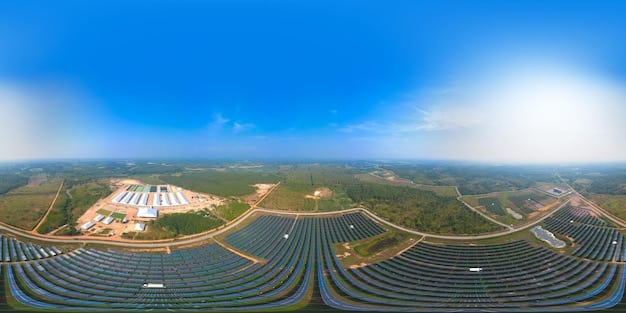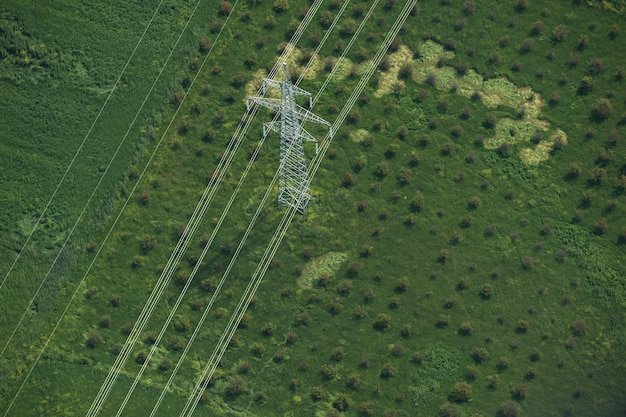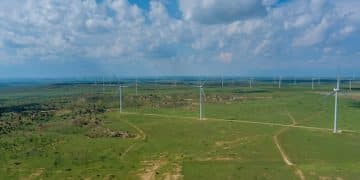Energy Storage: Powering the US Renewable Energy Transition

Energy storage is critical for achieving a 100% renewable energy future in the US by addressing the intermittency of renewable sources, enhancing grid stability, and enabling greater energy independence.
The transition to 100% renewable energy in the United States hinges on effective energy management. Energy storage solutions are at the heart of this transformation, providing the necessary tools to overcome the challenges of intermittent renewable sources and ensure a reliable, sustainable energy future.
Understanding the Critical Role of Energy Storage
Energy storage is no longer just an add-on; it’s an essential component for integrating renewable energy sources into the US power grid. It addresses the fundamental issue of matching energy supply with demand, especially when dealing with the variability of solar and wind power.
This section explores the various ways energy storage strengthens the renewable energy infrastructure, ensuring a seamless transition to a cleaner energy future.
Addressing Renewable Energy Intermittency
Renewable energy sources like solar and wind are inherently variable. Energy storage helps to smooth out these fluctuations and provide a consistent power supply.
Enhancing Grid Stability
A stable grid is essential for a reliable energy supply. Energy storage provides crucial support for maintaining grid frequency and voltage, even as renewable energy sources become more prevalent.
- Mitigating the variability of renewable energy sources.
- Providing backup power during grid outages.
- Optimizing the use of existing grid infrastructure.
By effectively managing energy supply and demand, energy storage plays a central role in ensuring a smooth transition to a renewable energy-powered grid. This reduces reliance on fossil fuels and promotes environmental sustainability.

Types of Energy Storage Technologies
The energy storage landscape is diverse, with various technologies offering unique benefits and addressing different needs. Understanding these technologies is essential for selecting the right solution for specific applications.
This section provides an overview of the most prominent energy storage technologies, including their capabilities, advantages, and limitations.
Battery Storage Systems
Battery storage systems, particularly lithium-ion batteries, are widely used for their high energy density and rapid response times. They are ideal for short-duration storage and grid stabilization.
Pumped Hydro Storage
Pumped hydro storage is a mature technology that involves pumping water uphill to a reservoir and releasing it to generate electricity when needed. It offers large-scale, long-duration energy storage capabilities.
- Compressed Air Energy Storage (CAES)
- Thermal Energy Storage (TES)
- Flow Batteries
Each of these technologies has its strengths, making them suitable for different applications within the evolving energy storage ecosystem. The ongoing development and deployment of these technologies are essential for achieving a resilient and sustainable energy future.
Benefits of Energy Storage for the US Renewable Transition
The advantages of energy storage extend far beyond simply storing excess energy. They encompass economic, environmental, and social benefits that are crucial for a successful transition to a 100% renewable energy system in the US.
This section highlights the various ways energy storage contributes to a more sustainable, secure, and equitable energy future.
Economic Advantages
Energy storage can reduce energy costs by enabling more efficient use of renewable energy sources and reducing reliance on expensive peak power plants.
Environmental Benefits
By facilitating the integration of renewable energy, energy storage reduces greenhouse gas emissions and promotes a cleaner environment.
- Creating new jobs in the energy storage industry.
- Reducing transmission congestion and improving grid efficiency.
- Supporting energy independence and reducing reliance on fossil fuel imports.
These benefits demonstrate that investing in energy storage is not just an environmental imperative but also a sound economic strategy that supports long-term prosperity and energy security.

Challenges and Opportunities in Energy Storage Deployment
While the potential of energy storage is immense, several challenges need to be addressed to accelerate its deployment in the US. Overcoming these obstacles will unlock significant opportunities for innovation, economic growth, and environmental stewardship.
This section explores the key challenges and opportunities associated with the widespread adoption of energy storage technologies.
Cost Reduction
Reducing the cost of energy storage technologies is crucial for making them more competitive with traditional energy sources.
Regulatory Framework
Clear and supportive regulatory frameworks are needed to incentivize energy storage deployment and ensure fair market access.
- Developing advanced energy storage technologies.
- Increasing public awareness and acceptance of energy storage.
- Promoting collaboration between industry, government, and research institutions.
By addressing these challenges and seizing the opportunities, the US can accelerate the deployment of energy storage and pave the way for a cleaner, more resilient, and sustainable energy future.
Policy and Regulatory Support for Energy Storage
Government policies and regulations play a pivotal role in shaping the energy storage market and driving its growth. Supportive policies can incentivize investment, reduce barriers to entry, and create a level playing field for energy storage technologies.
This section examines the key policy and regulatory mechanisms that are essential for fostering a thriving energy storage industry in the US.
Investment Tax Credits (ITCs)
ITCs can provide significant financial incentives for energy storage projects, making them more economically viable.
Grid Services Compensation
Establishing clear mechanisms for compensating energy storage for the grid services it provides, such as frequency regulation and voltage support, is crucial for its economic sustainability.
- Streamlining permitting processes for energy storage projects.
- Developing energy storage procurement targets and mandates.
- Promoting energy storage research and development.
These policy and regulatory measures are essential for creating a stable and predictable market environment that encourages investment in energy storage and facilitates its integration into the US energy system.
The Future of Energy Storage in the US
The future of energy storage in the US is bright, with ongoing technological advancements, increasing market demand, and growing policy support. As renewable energy sources continue to expand, energy storage will play an increasingly vital role in ensuring a reliable, affordable, and sustainable energy supply.
This section provides a glimpse into the future of energy storage, highlighting the trends and innovations that will shape its development and deployment.
Advanced Battery Technologies
Ongoing research and development are leading to new battery technologies with higher energy densities, longer lifespans, and lower costs.
Grid-Scale Energy Storage
Large-scale energy storage projects are becoming increasingly common, providing significant capacity for balancing the grid and integrating renewable energy sources.
- Integration of energy storage with electric vehicles (EVs).
- Development of innovative financing models for energy storage projects.
- Increased adoption of energy storage in residential and commercial settings.
These developments suggest that energy storage will become an indispensable component of the US energy system, enabling a cleaner, more resilient, and more sustainable energy future for all.
| Key Point | Brief Description |
|---|---|
| ⚡ Intermittency Solution | Energy storage addresses the variability of renewable sources like solar and wind. |
| 🔋 Technology Variety | Various storage types exist, including batteries, pumped hydro, and compressed air. |
| 💰 Economic Benefits | Energy storage reduces energy costs and reliance on peak power plants. |
| 🌱 Environmental Impact | It reduces greenhouse gas emissions and supports a cleaner environment. |
Frequently Asked Questions
▼
Energy storage addresses the intermittent nature of renewable energy sources like solar and wind, enabling a constant and reliable power supply even when these sources are not actively generating.
▼
The primary types include battery storage (lithium-ion, flow batteries), pumped hydro storage, compressed air energy storage (CAES), and thermal energy storage (TES), each with different applications.
▼
Energy storage helps maintain grid frequency and voltage, manages fluctuations from renewable sources, and provides backup power during outages, improving the overall reliability of the grid.
▼
Investment Tax Credits (ITCs), grid service compensation mechanisms, streamlined permitting processes, and procurement targets all promote energy storage deployment and market growth.
▼
The future includes advanced battery technologies, increased grid-scale storage projects, integration with electric vehicles, and innovative financing models, positioning energy storage as an indispensable component.
Conclusion
Energy storage is undeniably a foundational element for the US transition to 100% renewable energy. By mitigating the intermittency of renewables, enhancing grid stability, and offering economic and environmental benefits, it paves the way for a sustainable, secure, and resilient energy future.





